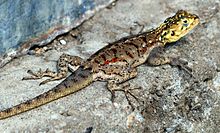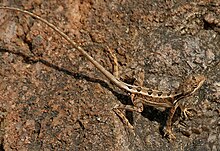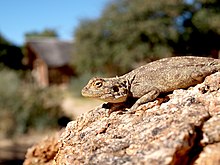
Lizard is the common name used for all squamate reptiles other than snakes, encompassing over 7,000 species, ranging across all continents except Antarctica, as well as most oceanic island chains. The grouping is paraphyletic as some lizards are more closely related to snakes than they are to other lizards. Lizards range in size from chameleons and geckos a few centimeters long to the 3-meter-long Komodo dragon.

Squamata is the largest order of reptiles, comprising lizards and snakes. With over 11,500 species, it is also the second-largest order of extant (living) vertebrates, after the perciform fish. Members of the order are distinguished by their skins, which bear horny scales or shields, and must periodically engage in molting. They also possess movable quadrate bones, making possible movement of the upper jaw relative to the neurocranium. This is particularly visible in snakes, which are able to open their mouths very wide to accommodate comparatively large prey. Squamates are the most variably sized living reptiles, ranging from the 16 mm (0.63 in) dwarf gecko to the 6.5 m (21 ft) reticulated python. The now-extinct mosasaurs reached lengths over 14 m (46 ft).
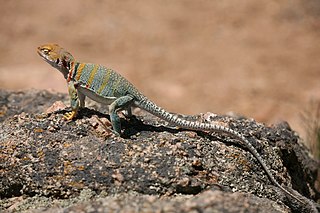
The Crotaphytidae, or collared lizards, are a family of desert-dwelling reptiles native to the Southwestern United States and northern Mexico. Alternatively they are recognized as a subfamily, Crotaphytinae, within the clade Pleurodonta. They are very fast-moving animals, with long limbs and tails; some species are capable of achieving bipedal running at top speed. This species is carnivorous, feeding mainly on insects and smaller lizards. The two genera contain 12 species.

Ceratophora is a genus of agamid lizards found in Sri Lanka. The male has a horn on its snout.

Draco is a genus of agamid lizards that are also known as flying lizards, flying dragons or gliding lizards. These lizards are capable of gliding flight via membranes that may be extended to create wings (patagia), formed by an enlarged set of ribs. They are arboreal insectivores.

The thorny devil, also known commonly as the mountain devil, thorny lizard, thorny dragon, and moloch, is a species of lizard in the family Agamidae. The species is endemic to Australia. It is the sole species in the genus Moloch. It grows up to 21 cm (8.3 in) in total length, with females generally larger than males.
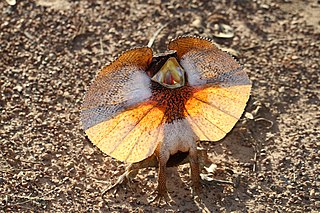
The frilled lizard, also known as the frillneck lizard, frill-necked lizard or frilled dragon, is a species of lizard in the family Agamidae. It is native to northern Australia and southern New Guinea. This species is the only member of the genus Chlamydosaurus. Its common names come from the large frill around its neck, which usually stays folded against the lizard's body. It reaches 90 cm (35 in) from head to tail and can weigh 600 g (1.3 lb). Males are larger and more robust than females. The lizard's body is generally grey, brown, orangish-brown, or black in colour. The frills have red, orange, yellow, or white colours.
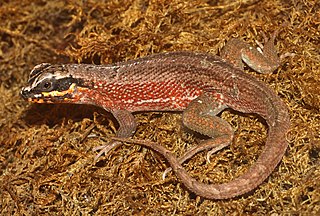
Iguania is an infraorder of squamate reptiles that includes iguanas, chameleons, agamids, and New World lizards like anoles and phrynosomatids. Using morphological features as a guide to evolutionary relationships, the Iguania are believed to form the sister group to the remainder of the Squamata, which comprise nearly 11,000 named species, roughly 2000 of which are iguanians. However, molecular information has placed Iguania well within the Squamata as sister taxa to the Anguimorpha and closely related to snakes. The order has been under debate and revisions after being classified by Charles Lewis Camp in 1923 due to difficulties finding adequate synapomorphic morphological characteristics. Most Iguanias are arboreal but there are several terrestrial groups. They usually have primitive fleshy, non-prehensile tongues, although the tongue is highly modified in chameleons. The group has a fossil record that extends back to the Early Jurassic. Today they are scattered occurring in Madagascar, the Fiji and Friendly Islands and Western Hemisphere.

Draco dussumieri, also known commonly as the Indian flying lizard, the southern flying lizard, and the Western Ghats flying lizard, is a species of lizard in the family Agamidae. The species is capable of gliding from tree to tree. It is found principally in the Western Ghats and some other hill forests of Southern India. It is almost completely arboreal, found on trees in forests and adjoining palm plantations where it climbs trees to forage for insects and glides to adjoining trees by expanding the patagium, loose skin on the sides of the body which is supported by elongated ribs to act as wings. The skin on the sides of the neck is also extended to the sides using the hyoid bones of the tongue as support. During the breeding season males maintain small territories which they defend from other males while courting females. The male has a more colourful patagium than the female, and it prominently extends its yellow dewlap forward in display. Although living almost its entire life in trees, the female descends to the ground to lay eggs in soil. This is the species with the westernmost distribution within the genus Draco, the majority of species occurring in Southeast Asia.
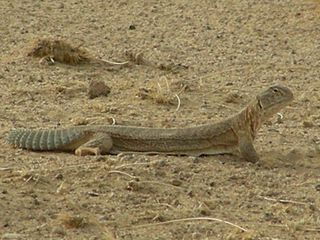
Saara hardwickii, commonly known as Hardwicke's spiny-tailed lizard or the Indian spiny-tailed lizard is a species of lizard in the family Agamidae. The species is found in patches across the Thar desert, Kutch, and surrounding arid zones in India and Pakistan. It is mainly herbivorous and lives in numbers in some areas. Since it is found in loose clusters it often attracts predators such as raptors. It is also hunted by local peoples in the belief that the fat extracted from it is an aphrodisiac.
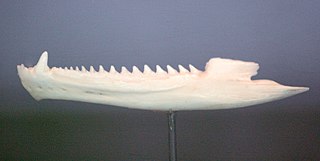
Acrodonty is an anatomical placement of the teeth at the summit of the alveolar ridge of the jaw, without sockets, characteristic of bony fish. Functionally, acrodont tooth implantation may be related to strong bite force.

Barbaturex is an extinct genus of giant herbivorous iguanian lizards from Pondaung Formation, the Eocene of Myanmar. It is represented by a single species, Barbaturex morrisoni, which is known from several partial dentaries and a fused pair of frontals, two bones that form part of the top of the skull. Based on the size of these bones, Barbaturex morrisoni is estimated to have been about 1 metre (3.3 ft) from snout to vent, and possibly up to 6 feet (1.8 m) including the tail. Barbaturex morrisoni was named after The Doors frontman Jim Morrison, a play on his epithet "The Lizard King". The genus's name is a portmanteau of the Latin words Barbatus and rex, meaning "bearded king", in reference to ridges along the mandible and the lizard's large size.

Scincogekkonomorpha is a clade of lizards that includes scleroglossans and all lizards more closely related to scleroglossans than to iguanians. These "stem" scleroglossans include extinct lizards from the Late Jurassic and Early Cretaceous such as Bavarisaurus, Eichstaettisaurus, Liushusaurus, and Scandensia. Scincogekkonomorpha was named in 1961 and is now occasionally used as a stem-based taxon in contrast to the node-based taxon Scleroglossa. According to phylogenies based on morphological characteristics, Scincogekkonomorpha is the sister taxon of Iguania and together they make up crown group Squamata, the smallest clade including all living snakes and lizards.

Chamaeleontiformes is a hypothesized clade of iguanian lizards defined as all taxa sharing a more recent common ancestor with Chamaeleo chamaeleon than with Hoplocercus spinosus, Polychrus marmoratus, or Iguana iguana. It was named by paleontologist Jack Conrad in 2008 to describe a clade recovered in his phylogenetic analysis that included the extinct genus Isodontosaurus, the extinct family Priscagamidae, and the living clade Acrodonta, which includes agamids and chameleons. It is a stem-based taxon and one of two major clades within Iguania, the other being Pleurodonta. Below is a cladogram from Daza et al. (2012) showing this phylogeny:
Bharatagama is an extinct genus of lepidosaur from the Early Jurassic of India. It has been suggested to be one of the oldest known lizards and the oldest known iguanian. The type and only species is Bharatagama rebbanensis, named in 2002. Over one hundred fossils of Bharatagama have been found in the Kota Formation, which outcrops in the Pranhita–Godavari Basin and dates back to about 190 million years ago (Ma). Despite its abundance, Bharatagama is known only from isolated jaw bones mixed together in microvertebrate assemblages with equally fragmentary remains of fish, sphenodontians, dinosaurs, crocodylomorphs, and mammals. These fossils represent all stages of development, from hatchlings to adults. The total length of the skull in adult specimens is estimated to have been about 15 millimetres (0.59 in). Later analysis suggested that the taxon might be a member of Rhynchocephalia.

Diploderma swinhonis, also known commonly as the Taiwan japalure, Swinhoe's japalure, Swinhoe's lizard, and Swinhoe's tree lizard, is a species of lizard in the family Agamidae. The species is native to Taiwan. It is considered an invasive alien species in Japan after likely being transported from Taiwan by humans. A foraging ambush predator, this lizard preys primarily on arthropods and thus remains at the bottom of forests perched on trees where sunlight is present. D. swinhonis is not a major threat to humans and is able to adapt to a variety of habitats, including urban environments. The male D. swinhonis is physically distinct from the female, with its body size being much larger and having a yellow stripe. This species sexually reproduces on a seasonal basis and hibernates during the winter time.

Acrodonta are a subclade of iguanian squamates consisting almost entirely of Old World taxa. Extant representation include the families Chamaeleonidae (chameleons) and Agamidae, with at least over 500 species described. A fossil genus, Gueragama, was found in Brazil, making it the only known American representative of the group.
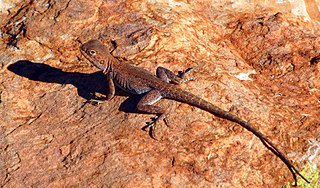
Ctenophorus caudicinctus, commonly known as the ring-tailed dragon or ring-tailed bicycle-dragon is a native species of agamid lizard occurring in rocky ranges and outcrops of Australia. Ctenophorus caudicinctus is most commonly found in the Pilbara region and offshore islands of Western Australia. The ctenophorus has 28 known species in the northern, southern, and western parts of Australia. It is recognized to be the most speciose group of Australian agamids.
Ctenophorus mckenziei, more commonly known as the dwarf-bicycle dragon, is a species of endemic Australian lizard within the family Agamidae and genus Ctenophorus. Originally identified as the agamid Amphibolurus mckenziei, the lizard had been identified within the regions of Western Australia and South Australia in which it occupied the shrubbery and woodland areas as its habitat. It was subsequently transferred to the genus Ctenophorus along with other Agamid species in which it shared similar morphology and characteristics. The name mckenziei is in reference to Norman Leslie Mckenzie, who was a zoologist and discovered the existence of the lizard. Listed on the IUCN red list page, threats to its population numbers are evaluated as least concern; however, their numbers are threatened by habitat loss, climate change, and feral predators.
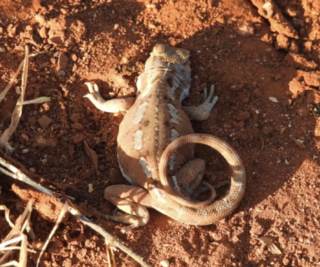
Ctenophorus parviceps, commonly known as the Gnaraloo heath dragon or northwestern heath dragon is a species of agamid lizard occurring in pale coastal sands and shell grit with open heaths and beach spinifex, between the North West Cape and Carnarvon, Western Australia and on Bernier Island. The Gnaraloo heath dragon is a lizard that can be found along the coast of Western Australia between Exmouth Gulf and Shark Bay, and is also known as the northwestern heath dragon. It is native to Australia and usually inhabits sandy coastal dunes. The species' longevity is 3–50 years and its population density is extremely low. The Gnaraloo heath dragon is a member of the Agamidae family, which contains 15 genera. The lizard is under the Ctenophorus genus which has up to 33 species. This genus shows the most morphological and ecological diversity out of the three large agamid genera. 83% of the lizards in this genus lack a crest, while 17% possess crests. They are smaller than most agamids but do have relatively large heads. The Gnaraloo heath dragon can be differentiated from related species by a series of spines on the tail's base, a pale-grey brown broad vertebral band along its back, and hour-glass bars extending upwards to meet the pale vertebral band. It is usually 45mm in terms of length, measuring from snout to vent.

